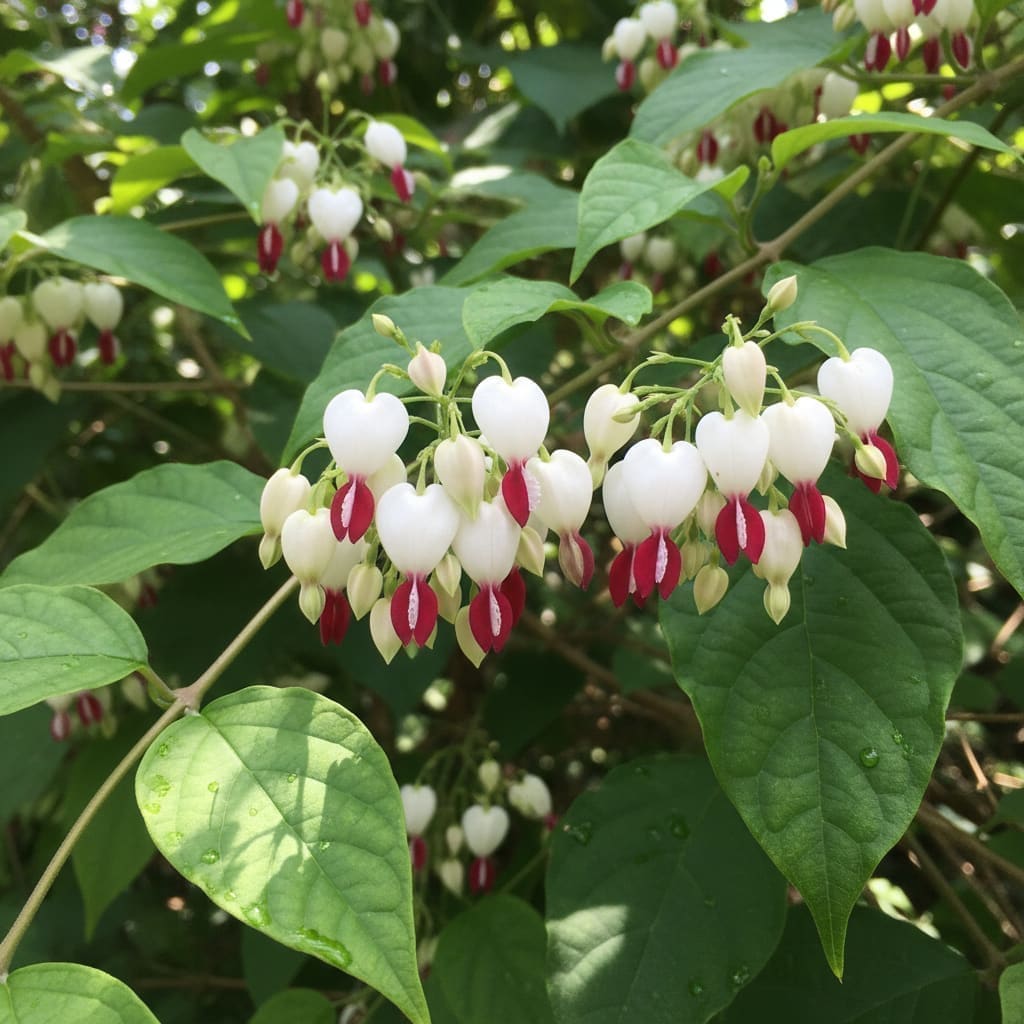Clerodendrum thomsoniae (Bleeding Heart Vine) Care Guide
Overview
Clerodendrum thomsoniae, commonly known as the Bleeding Heart Vine
Clerodendrum thomsoniae is a woody, twining vine that can climb or trail depending on support. In the wild, it can reach several meters in length. Its leaves are opposite, glossy, and ovate with a pointed tip, typically 3–6 inches long. The plant produces pendulous clusters of flowers: each bloom has a papery white calyx from which emerges a tubular, bright red corolla. Flowering often occurs in warm months, especially when the plant receives ample light and humidity. For best growth and flowering, place the Bleeding Heart Vine in bright, indirect light. It can tolerate some direct morning sunlight, which may enhance blooming, but avoid intense afternoon sun that can scorch foliage. Indoors, an east- or west-facing window with filtered light is ideal. Outdoors, provide dappled shade or a location with gentle morning sun. Water thoroughly when the top 1–2 inches of soil feel dry. Ensure excess water drains freely to prevent root rot. Reduce watering during the plant’s semi-dormant period in winter, allowing the soil to dry slightly more between waterings. This species prefers high humidity (50–70%). In dry indoor climates, increase humidity by: Use a well-draining potting mix with a slightly acidic to neutral pH. A blend of peat moss, perlite, and compost works well. Repot every 1–2 years in spring, or when roots outgrow the container. Choose a pot with drainage holes to avoid waterlogging. Feed every 4–6 weeks during the active growing season (spring through early fall) with a balanced, water-soluble fertilizer diluted to half strength. Avoid over-fertilizing, which can lead to excessive leafy growth at the expense of flowers. Suspend feeding in winter. Prune after flowering to maintain shape and encourage branching. Remove dead or weak stems to improve airflow. Clerodendrum thomsoniae responds well to training: Clerodendrum thomsoniae is considered toxic if ingested. Keep it out of reach of pets and children, and wear gloves when pruning if you have sensitive skin. Showcase the Bleeding Heart Vine where its trailing or climbing habit can be appreciated. Indoors, train it on a decorative trellis in a bright sunroom or let it cascade from a hanging basket. Outdoors in warm climates, it can be used to cover arbors, pergolas, or fences, adding a tropical flair and seasonal bursts of color. While the classic form is most common, some cultivars may have slightly different flower sizes or leaf variegation. Availability varies by region and nursery stock. When purchasing, look for plants with healthy, pest-free foliage and no signs of wilting or yellowing. Flowering specimens can be appealing, but non-blooming plants may establish more quickly after transplanting. Mature plants, when given proper care, can bloom multiple times per year in suitable climates. For more information, see the Clerodendrum thomsoniae entry on Wikipedia. For a fuller, more floriferous vine, pinch back growing tips regularly during the active season to stimulate lateral shoots. Consider espalier training against a decorative frame for a living wall effect. In greenhouse settings, layering stems into adjacent pots can create multi-tiered displays. For bonsai-style experimentation, select a single stem and prune to maintain a woody trunk, encouraging a miniature tree form with seasonal blooms. Pair Bleeding Heart Vine with plants that share similar humidity and light needs to create lush groupings:Identification & Growth Habit
Light & Placement
Watering & Humidity
Soil & Repotting
Fertilizing
Pruning & Training
Propagation (Step-by-Step)
Common Problems
Pests
Diseases
Toxicity & Pet Safety
Styling & Decor Tips
Varieties & Cultivars
Buying Tips & Maturity
Seasonal Care
FAQ
Troubleshooting Scenarios
Advanced Pruning & Training Techniques
Companion Plant Suggestions
Do & Don't List






